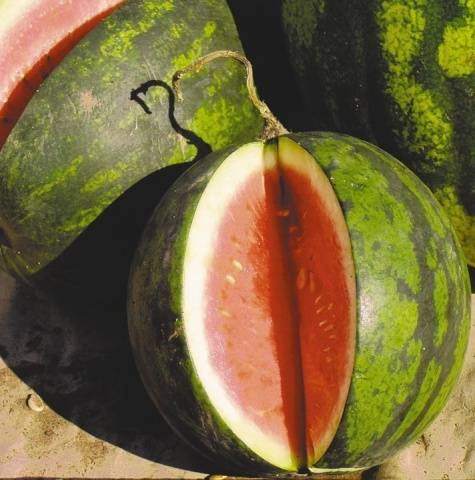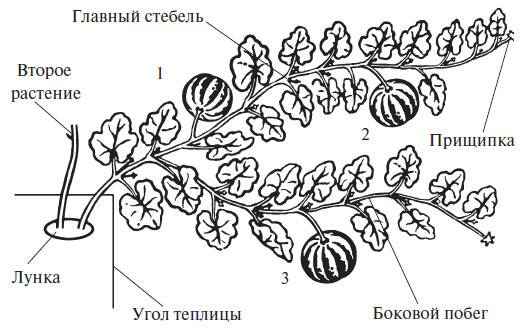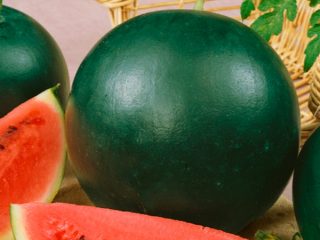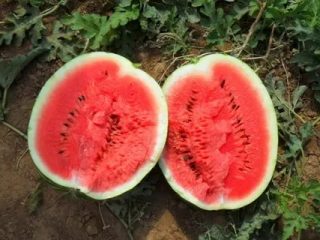Content
Warm and generous August brings an abundance of fruits and vegetables. There is a demand for imported watermelons in the markets. And some prudent owners of summer cottages grow watermelons in their greenhouses. There are a lot of problems with this crop in the conditions of central Russia, but by selecting varieties and fulfilling the requirements of agricultural technology, you get delicious fruits at the end of summer.
Growing conditions
Before growing watermelon in a greenhouse in the Moscow region, the Urals and Siberia, you need to familiarize yourself with new agricultural technology.
- Watermelons are propagated by seedlings;
- Early ripening varieties are sown;
- A gardener needs to carefully study how to properly grow watermelons in a greenhouse: the crop’s requirements for temperature, humidity and soil;
- A successful harvest of melons in regions with a short warm period requires, in addition to guaranteed protection from return frosts, limiting the fruits on the bush, as well as proper planting and care of watermelons in a greenhouse.
How to prepare a greenhouse
The greenhouse is carefully prepared for growing watermelons.
- In cloudy summers, additional lighting is installed with LB-40 fluorescent lamps. They are especially useful when planting watermelons in a polycarbonate greenhouse. For a medium-sized greenhouse with a height of 2 m, it is enough to buy four lighting fixtures;
- The greenhouse should be located in a spacious place so that shadows from buildings or trees do not fall on it from the south and southwest;
- It is possible to safely grow watermelon in a greenhouse in the country if it is equipped with a trouble-free ventilation system. Watermelons come from the deserts of South Africa, so high humidity, more than 60%, which is usually observed in greenhouses, will harm them;
- Due to the drought resistance of the crop, you need to know what you can use to plant watermelons in a greenhouse. Melons, tomatoes and bell peppers will be good neighbors for watermelons;
- In joint plantings, watermelons are planted on the north side of the greenhouse. Tied up, they will shade low-growing crops with their densely leafy vines;
- It is better to prepare the soil for growing watermelons in a greenhouse in the fall. Apply grass, compost, and a bucket of humus and sand per 1 square meter on top. m.
The best varieties
There are several basic requirements for watermelons grown in a greenhouse in the country:
- Early ripening varieties of watermelons are planted, which in a short period of hot weather can be filled with sweet juice;
- Plants can withstand sudden changes in temperature during the day;
- Watermelons are resistant to cold snaps, which can last up to 10 days.
Watermelons intended for the greenhouse work well. Varieties bred for the southern regions are not worth buying.They choose hybrids and varieties of domestic and foreign selection for greenhouses, as well as well-proven old ones, like the famous Ogonyok. During the four months of growing season in the greenhouse, Crimstar, Crimson Sweet, Sugar Baby, Florida, Kai f1, Style, Memory Kholodova, Skorik, Podmoskovny Charleston f1, Super Early Dyutina, Gift to the North f1, Refined, Sibiryak, Pannonia f1 and some other varieties ripen in the greenhouse.
Ogonyok
Launched in 1960, it was intended for the center of the country, Siberia and the Far East. Every year the variety is grown in gardens and does not lose its position. Suitable for growing watermelons in polycarbonate greenhouses. Fruits weighing 1-1.5 kg ripen in 75-85 days. The skin is thin but durable. The flesh is bright red and sweet. Moderately susceptible to fungal diseases and easily tolerates summer cold snaps. The originator is the Sortsemovoshch Association.
Kai f1
The hybrid was specially bred for cultivation in greenhouses in Northern European regions with low levels of lighting and low temperatures. Distributed in Finland and Sweden. A fast-growing, early-ripening watermelon produces elongated fruits at 70-75 days. The rind is thin, there are few seeds in the aromatic, sweet raspberry-colored pulp. The fruits weigh 7-10 kg.
Sibiryak-97
A unique variety was created by Ural breeders. During field tests, being in the phases of seedlings and two true leaves, the plant showed resistance to sub-zero temperatures: up to -6 degrees. The weight of the fruit with sweet, crumbly, red pulp reaches 4-5 kg. The thin crust is dark green, with barely noticeable dark stripes on it. Ripens in a greenhouse in 70-80 days.
Gift to the North f1
An early ripening variety for greenhouses with stable yields. Watermelons weighing up to 10 kg ripen in 75-85 days.The pulp under the green crust with darker stripes is red, sugary, crispy. Watermelon withstands transportation well and is little affected by fungal diseases. The variety tolerates frost, even stagnant water near the root is not afraid of it.
Skorik
The variety has been included in the State Register since 1997, originator: Research Institute of Vegetable and Melon Growing in Astrakhan. Ultra-early watermelon - ripens after 65 days of growing season. The rounded fruits are medium-sized, 1.5-2 kg, very sweet. Stored in a cold place for more than 2 months. Belongs to the long-climbing watermelons. In the greenhouse it needs shaping: it needs to be pinched.
Crimstar
Ideal for a greenhouse. The variety from the Japanese company Sakata ripens in the shortest possible time: in 55 days. Watermelons are round and grow with an average weight of 5-8 kg. The pulp is red, 12% sugar content. The variety is adapted to unfavorable weather and is resistant to anthracnose. The fruits can withstand long-distance transportation and are stored for a long time.
Ultra early
An excellent variety for growing watermelons in a polycarbonate greenhouse: increased resistance to fungal diseases, as well as a compact bush. The plant produces few side shoots. The variety is early ripening: round fruits weighing 4-6 kg ripen in 80 days. The crust is dark green with blurry light spots and stripes. The pulp is raspberry, tender, tasty.
Growing seedlings
Before you start growing watermelons in polycarbonate greenhouses, you need to buy or prepare seedlings yourself. Choose an early ripening variety, purchase soil and containers for seedlings with sides 8-10 cm and the same depth. Sow seeds for seedlings for unheated greenhouses in early May. In heated greenhouses, watermelons are planted or sown with seeds in February-March. You can sow seeds in the ground in greenhouses without heating, on warm beds, in April.
Soil preparation
Since a high-quality harvest must be obtained from a southern crop in a greenhouse, the plant is supported with a balanced amount of fertilizer, starting with enriching the soil for seedlings. The purchased soil already contains minerals; nothing is added to it. Watermelons will use soil for cucumbers. If you took care of garden soil for seedlings in the fall and mixed it with humus in a ratio of 1:3, add 3 tbsp to a bucket of the mixture. spoons of superphosphate, 1 tbsp. a spoonful of potassium sulfate and ammonium nitrate, a glass of wood ash.
Seed preparation
The hard rind of watermelon seeds must be softened for the seed to hatch. Watermelon seeds are germinated in several ways:
- Place the seeds on a damp cloth until the sprout appears;
- The seeds are soaked in warm water for a day;
- Heat treatment is applied: seeds are placed in fabric bags, two containers with hot and cold water are prepared. First, the bag is placed in cold water for a few seconds, then in hot water for 2 seconds. This is repeated three times;
- Sprouted seeds are placed in pots one at a time, with the sprout facing up, and swollen seeds - two or three on the side.
Seedling care
The cups are covered with film to keep the soil moist. Before sprouts appear, you need to maintain the temperature at least 23-25 0C. Seeds germinate in 5-10 days. With the appearance of sprouts, the film is removed and the temperature is lowered slightly: 20 degrees during the day and 18 at night. The seedlings are well lit so that the sprouts do not stretch. In cloudy weather, additional lighting is turned on - up to 12-14 hours a day.
- If the seedlings are in small pots, they are placed so that the leaves do not touch;
- Water with moderately warm, settled water;
- After 10-12 days, the sprouts are fed with complex mineral fertilizers in accordance with the instructions. The second feeding is carried out after 10 days.
Features of care in a greenhouse
The seedlings are planted in the greenhouse after a month. Watermelons that have 4-5 leaves are transferred to an unheated shelter when warm weather sets in: 20 0With daytime and no frost at night, the earth warmed up to 14-15 0C. Planting watermelons in a greenhouse is carried out on warm beds. The distance between the holes is 80-100 cm. In the first days, if the weather is cool, low arcs are installed over the watermelon beds and the film is stretched.
Arrangement of beds
If the soil for the greenhouse has been prepared since the fall, another layer of fertile soil is placed on top and young watermelons are planted in the holes. Remove from the pots carefully, without exposing the roots. To do this, the plants are watered abundantly several hours before planting.
Warm beds are important in caring for watermelons in a greenhouse, because plants of any variety are capricious and delicate. If the beds are not ready, the top layer of soil in the greenhouse is removed. Compost or compacted hay or straw is placed below, humus is covered on top and the area is filled with hot water. After 4-6 days, apply a fertile layer of soil mixed with 3 tbsp. spoons of nitrophoska and 1 tbsp. spoon of superphosphate per 1 sq. m, and seedlings are planted. Sand is added to clay soils for looseness.
Formation
The plants are constantly looked after. When growing watermelons in a greenhouse, a bush is formed.
- The soil is loosened and removed weeds;
- Bushes are hilled to increase the number of roots;
- As soon as the female flowers appear, the lashes are pinched off;
- New lashes are removed. Growing watermelons in a greenhouse is mandatory to avoid thickening and normalize fruiting;
- Water with moderately warm water. Before flowering - three times a week, later once a week, without moistening the base of the stem and leaves;
- Fertilize every 10 days with your choice of potassium humate, 20 g of ammonium nitrate per bucket of water or a mineral complex;
- According to the scheme for forming a watermelon in a greenhouse, when the ovaries grow the size of a plum, one is left on each of the vines. Three leaves after the ovary, the lash is pinched. There should not be more than three fruits on one root.
Pollination
With the appearance of male flowers, which quickly fade, the greenhouse rushes to manually pollinate the female ones. The flower is picked and the anthers are applied to the stigmas on the female flower. All female flowers are pollinated, and then the best ovaries are selected.
Garter of whips
Growing watermelons on a trellis in greenhouses is a better care option than developing vines into a spread. The plant receives more light, the leaves are ventilated, and there are fewer preconditions for diseases. As the lashes grow, they are tied to the trellises. Nets for watermelon ovaries are also attached to supports in the greenhouse. The tensioning schemes are simple; you need to make sure that the lashes are given room to develop freely.
Culture will have to be given maximum attention. Properly grown fruits will be sweet and will delight gardeners.























